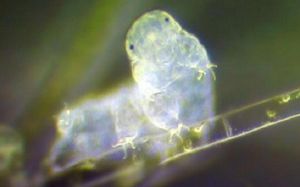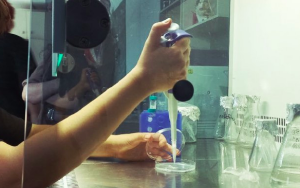No edit summary |
Tag: 2017 source edit |
||
| (12 intermediate revisions by 3 users not shown) | |||
| Line 1: | Line 1: | ||
[[File:14528515709033 546x0.jpg|thumb]] | [[File:14528515709033 546x0.jpg|thumb]] | ||
'''Tardigrades''' are microscopic animals | '''Tardigrades''' are invertebrate microscopic animals popularly known as '''water bears''' and notorious for their incredible ability to survive in extreme conditions. These organisms measure between 0.3 mm and 0.5 mm, although some can reach up to 1 mm. They are characterised by a cylindrical body, segmented into four pairs of legs with claws at the ends. | ||
This is made possible by their ability to shut down their organs when environmental conditions are not suitable ( | Their body is covered by an external cuticle, which they shed periodically. They are bilaterally symmetrical and have a complete digestive system, but lack a respiratory and circulatory system. Instead, they obtain oxygen by diffusion through their skin. They are aquatic animals and live in humid enviromets such as '''mosses''', lichens, wet soils and even in seawater and freshwater, where they feed on plant cells or small invertebrates.[[File:Istockphoto-1295483613-612x612.jpg|thumb]]They have become truly remarkable for their '''high resistance''' to extreme environments such as freezing at temperatures close to absolute zero, high temperatures up to 150°C, extreme dehydration, starvation for decades, high levels of radiation and space vacuum, extreme pressures, both high and low... This is made possible by their ability to shut down their organs and stop their metabolism when environmental conditions are not suitable (this is called '''cryptobiosis''') and come back to life when optimal conditions are restored. | ||
One of the reasons these organisms are so resilient is because of a protein that only they produce. These abundant heat-soluble cytoplasmic proteins (CAHS) cause the inside of the cells to turn into a gel, which prevents the cell from collapsing. [[File:Tardigradee.png|thumb|tardigrades in the laboratory]]The '''reproduction''' is mainly sexual, although in some species asexual reproduction by parthenogenesis is observed. Females lay their eggs during cuticle shedding, and fertilisation occurs within the cuticle, or in the external environment in some species. | |||
The study of tardigrades has attracted great interest due to their extraordinary resilience, which could have applications in '''biomedicine''', '''astrobiology''' and '''tissue preservation technologies'''. They are also used as '''biomarkers''' to study the impact of climate change and pollution in extremophile environments. | |||
==To grow them in the laboratory== | |||
[[File: | we needed to reproduce their living environment and feed them. | ||
We cultivated the specie ''Hypsibius exemplaris'' in a 25ml plastic bottle. | |||
We cultivated separately a culture of the alga "Chlorococcum" in a tube containing spring water (Volvic) and 0,01% of fertilizer (Algabloom). We kept in them in the tent for the algae, with 12h light exposure cycles. | |||
Once a week, we fed the algae to the tardigrades as follows (each step needs a different sterile pipette tip): | |||
* Remove from the tardigrade culture half of the water on the top, without moving the biomass on the bottom | |||
* Replace the taken amount of water with the water coming from the Chlorococcus culture, aiming at taking the algae. | |||
* Refill the Chlorococcus culture with sterile cultivation medium (spring water with 0,01% of fertilizer algabloom) | |||
To observe them, with a sterile tip, take 200µl of water in the biomass at the bottom, put them on a slide and use the 10x magnification lens of the microscope to see them. [[File:In the lab.png|thumb|disolving the sample]] | |||
Webgraphy_ | |||
[https://www.ngenespanol.com/animales/descubren-por-que-los-tardigrados-son-practicamente-indestructibles-y-sobreviven-a-condiciones-extremas/:~:text=Estos%20animales%20diminutos%20son%20capaces,falta%20de%20alimento%20y%20agua.&text=En%20escenarios%20hostiles%20o%20fatales,mostrado%20una%20resistencia%20casi%20indestructible. Fischer, A. (2022, 7 julio). ''Tardígrados: qué son, dónde viven y cómo caminan (osos de agua)''. National Geographic En Español. https://www.ngenespanol.com/animales/tardigrados-que-son-donde-viven-como-caminan-osos-de-agua/] | |||
''' | Montejo, E. (2022, 22 septiembre). ''Científicos revelan el secreto que hace inmortal a los tardígrados''. National Geographic En Español. <nowiki>https://www.ngenespanol.com/animales/descubren-por-que-los-tardigrados-son-practicamente-indestructibles-y-sobreviven-a-condiciones-extremas/</nowiki> | ||
Wikipedia collaborators. (2024, 3 septiembre). ''Tardigrada''. Wikipedia, la Enciclopedia Libre. <nowiki>https://es.wikipedia.org/wiki/Tardigrada</nowiki> | |||
Latest revision as of 12:50, 14 October 2024
Tardigrades are invertebrate microscopic animals popularly known as water bears and notorious for their incredible ability to survive in extreme conditions. These organisms measure between 0.3 mm and 0.5 mm, although some can reach up to 1 mm. They are characterised by a cylindrical body, segmented into four pairs of legs with claws at the ends.
Their body is covered by an external cuticle, which they shed periodically. They are bilaterally symmetrical and have a complete digestive system, but lack a respiratory and circulatory system. Instead, they obtain oxygen by diffusion through their skin. They are aquatic animals and live in humid enviromets such as mosses, lichens, wet soils and even in seawater and freshwater, where they feed on plant cells or small invertebrates.
They have become truly remarkable for their high resistance to extreme environments such as freezing at temperatures close to absolute zero, high temperatures up to 150°C, extreme dehydration, starvation for decades, high levels of radiation and space vacuum, extreme pressures, both high and low... This is made possible by their ability to shut down their organs and stop their metabolism when environmental conditions are not suitable (this is called cryptobiosis) and come back to life when optimal conditions are restored. One of the reasons these organisms are so resilient is because of a protein that only they produce. These abundant heat-soluble cytoplasmic proteins (CAHS) cause the inside of the cells to turn into a gel, which prevents the cell from collapsing.
The reproduction is mainly sexual, although in some species asexual reproduction by parthenogenesis is observed. Females lay their eggs during cuticle shedding, and fertilisation occurs within the cuticle, or in the external environment in some species.
The study of tardigrades has attracted great interest due to their extraordinary resilience, which could have applications in biomedicine, astrobiology and tissue preservation technologies. They are also used as biomarkers to study the impact of climate change and pollution in extremophile environments.
To grow them in the laboratory
we needed to reproduce their living environment and feed them.
We cultivated the specie Hypsibius exemplaris in a 25ml plastic bottle.
We cultivated separately a culture of the alga "Chlorococcum" in a tube containing spring water (Volvic) and 0,01% of fertilizer (Algabloom). We kept in them in the tent for the algae, with 12h light exposure cycles.
Once a week, we fed the algae to the tardigrades as follows (each step needs a different sterile pipette tip):
- Remove from the tardigrade culture half of the water on the top, without moving the biomass on the bottom
- Replace the taken amount of water with the water coming from the Chlorococcus culture, aiming at taking the algae.
- Refill the Chlorococcus culture with sterile cultivation medium (spring water with 0,01% of fertilizer algabloom)
To observe them, with a sterile tip, take 200µl of water in the biomass at the bottom, put them on a slide and use the 10x magnification lens of the microscope to see them.
Webgraphy_
Montejo, E. (2022, 22 septiembre). Científicos revelan el secreto que hace inmortal a los tardígrados. National Geographic En Español. https://www.ngenespanol.com/animales/descubren-por-que-los-tardigrados-son-practicamente-indestructibles-y-sobreviven-a-condiciones-extremas/
Wikipedia collaborators. (2024, 3 septiembre). Tardigrada. Wikipedia, la Enciclopedia Libre. https://es.wikipedia.org/wiki/Tardigrada



